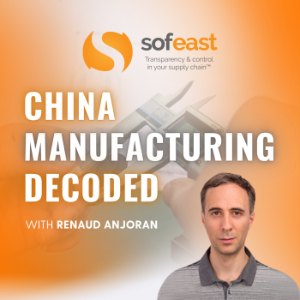
China Manufacturing Decoded
Business & Economics Podcasts
Join Renaud Anjoran, Founder & CEO of Sofeast, in this podcast aimed at importers who develop their own products as he discusses the hottest topics and shares actionable tips for manufacturing in China & Asia today!
WHO IS RENAUD?
Renaud is a French ISO 9001 & 14001 certified lead auditor, ASQ certified Quality Engineer and Quality Manager who has been working in the Chinese manufacturing industry since 2005. He is the founder of the Sofeast group that has over 200 staff globally and offers services (QA, product development & engineering, project management, Supply Chain Management, product compliance, reliability testing), contract manufacturing, and 3PL fulfillment for importers and businesses who develop their own products and buyers from China & SE Asia.
WHY LISTEN?
We‘ll discuss interesting topics for anyone who develops and sources their products from Asian suppliers and will share Renaud‘s decades of manufacturing experience, as well as inviting guests from the industry to get a different viewpoint. Our goal is to help you get better results and end up with suppliers and products that exceed your expectations!
Location:
Hong Kong
Description:
Join Renaud Anjoran, Founder & CEO of Sofeast, in this podcast aimed at importers who develop their own products as he discusses the hottest topics and shares actionable tips for manufacturing in China & Asia today! WHO IS RENAUD? Renaud is a French ISO 9001 & 14001 certified lead auditor, ASQ certified Quality Engineer and Quality Manager who has been working in the Chinese manufacturing industry since 2005. He is the founder of the Sofeast group that has over 200 staff globally and offers services (QA, product development & engineering, project management, Supply Chain Management, product compliance, reliability testing), contract manufacturing, and 3PL fulfillment for importers and businesses who develop their own products and buyers from China & SE Asia. WHY LISTEN? We‘ll discuss interesting topics for anyone who develops and sources their products from Asian suppliers and will share Renaud‘s decades of manufacturing experience, as well as inviting guests from the industry to get a different viewpoint. Our goal is to help you get better results and end up with suppliers and products that exceed your expectations!
Twitter:
@sofeast
Language:
English
Website:
https://www.sofeast.com/
How to Reduce Injection Molding Costs Without Sacrificing Quality & Reliability
Duración:00:34:02
What The October 30 Trump–Xi Trade Framework Means for US Importers
Duración:00:31:19
Designing for Toughness: How to Specify & Achieve the Right IK Rating
Duración:00:36:40
Who’s Responsible? EU & UK Product Compliance Explained (AR, Importers & Dropshipping) [Feat. Roberth Jonsson of 24HourAR]
Duración:00:36:25
When Wearables Fail: Swelling Rings, Cracked Watches, and Failing Earbuds
Duración:00:47:21
BONUS: China rare-earth export controls vs. U.S. 100% tariff threat + what it means for manufacturers
Duración:00:10:35
From Sketch to Factory: Industrial Design For Manufacturers (Feat. Vera Roldan)
Duración:00:30:14
Getting PR Right and Trade Fair Tips for Hardware Startups
Duración:00:18:49
Fail‑Safe by Design: Avoiding Catastrophic Product Failures
Duración:00:28:52
Choosing the Right Polymer Processing Method
Duración:00:36:18
Plastic Playbook: Choosing The Right Polymer
Duración:00:44:19
BONUS: China’s Oct 1 Export Overhaul: What Every Manufacturer Must Do Now
Duración:00:09:12
Prototype to Production: 7 Sneaky Pitfalls to Avoid
Duración:00:37:18
When To Sign Off On Injection Mold Tooling — Inside the Journey from DFM to T0→T2
Duración:00:31:26
Traffic Lights for Product Success. How Phase Gates Save Time & Money
Duración:00:37:40
Tariffs, Trade War, and the Factory Floor: Buyer Risks in 2025
Duración:00:38:33
Pilot Runs: Crucial for Manufacturing Success
Duración:00:32:21
India Overtakes China in US Smartphone Shipments: What It Really Means
Duración:00:33:55
Q&A: Invention > Marketplace, Shorter Manufacturing Timelines, China V West Biz Culture Differences, etc.
Duración:00:34:31
The Rise and Struggles of Smaller E-Commerce Sellers: Lessons from 2015 to Now
Duración:00:45:14